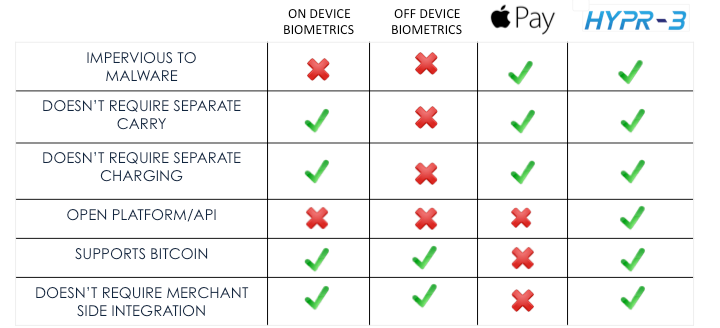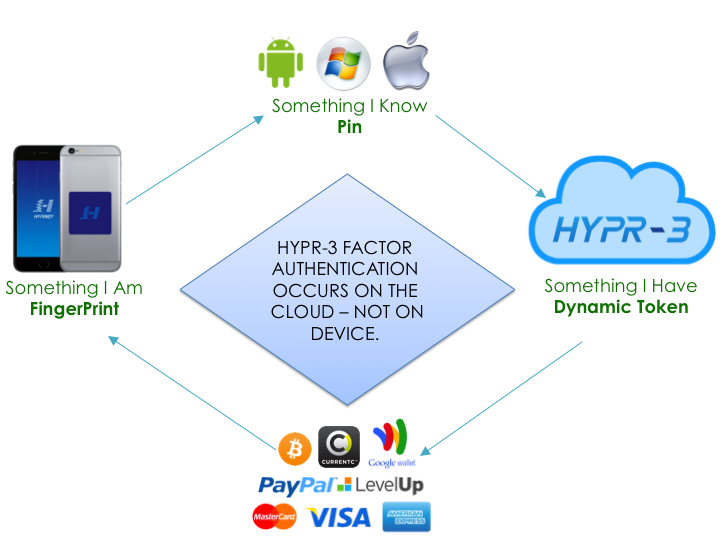A company based out of New York City called HyprKey aims to accomplish a three-factor level of security that credit cards, Apple Pay, CurrentC and Bitcoin haven’t.
The day of paying for goods and services with our mobile devices instead of swiping credit cards is dawning.
Apple Pay links customers’ credit cards to their mobile payment system, their ads seem to be everywhere, and their presence is increasing in stores.
Merchants like Walmart dislike these credit card payment networks as their processing fees to merchants are increasing. Walmart has recently joined a US$5 billion class action lawsuit against Visa for increasing fees. Then Apple Pay adds another fee on top of the pre-existing credit card fee.
In an effort to avoid these fees, Walmart and other merchants like Target, BestBuy, 7-Eleven, Exxon Mobil, Sears, and Rite-Aid, to only name a few, have began to integrate an alternative mobile payment system called CurrentC into their stores. It was developed by a trade association called the Merchant Customer Exchange, or MCX.
CurrentC is currently in development, and doesn’t integrate with credit cards; instead it directly links to consumers’ bank accounts through ACH.
To the dismay of many iPhone owners, the MCX merchants who are developing CurrentC have blocked Apple Pay. The CurrentC protocol works work with QR codes and bank accounts, but people are demanding the total opposite—credit cards and near field communications, or NFC.
The friction between these two technologies has resulted a mobile payments war. The problem is that on one hand, the retail sector is poised to offer a payment solution that can provide lower fees to merchants, while sacrificing customer convenience and security (CurrentC), and on the other, it already has a payment solution that provides the convenience and better security but increases merchants’ fees (Apple Pay).
How often do you hear of someone’s credit card being charged for something they didn’t purchase? No matter the charge, when fraud is the cause, the credit card owner is typically reimbursed by the credit card company.
Payment fraud is the reason that high card-processing fees exist. The processing banks' risk model is only balanced when the processing fees can offset these fraud rates. These costs fall back on merchants, and they will do almost anything to eliminate these fees, even backing CurrentC, which is stumbling out of the gate.
When merchants accept credit cards, they typically pay 3–5% of the total transaction to credit card companies. This amount consists of small interchange fees (ranging .90 percent to 1.50 percent on average) and the remaining fraud-fixing fees.
If fraud could be removed from the payment platform's risk model, then the high processing fees would fall significantly and a merchant would be left with a small interchange fee.
Enter HYPR-3
HyprKey claims it can eliminate payment fraud at the point of sale with HYPR-3, a new three-factor biometric authentication protocol to be launched in June 2015.

Effectively, it would allow customers to securely use credit cards, bitcoin, or third-party digital wallets when paying with their phones. Through dynamic tokenization, biometrically secured by a hardware component at the point of sale, HYPR-3 is designed to eliminate payment fraud and reduce processing fees for merchants.
How It Works
The user attaches the HYPR-3 bluetooth sticker to their device and swipes their finger.
By swiping this HYPR-3 bio sticker, which is approximately the size of a stick of chewing gum, users are actually generating a dynamic biometric token unique to their identity.

The protocol will also require the user to input a password on the operating system layer.
Together, this quick process replaces standard two-factor authentication with three factors: something I have (a phone), something I am (a person with a unique fingerprint), and something I know (a password).
HyprKey doesn’t plan to or even have the ability to store user information. The data necessary for token generation and biometric authentication never leaves the HYPR-3 device, therefore it cannot be intercepted by a malicious 3rd party.
Whatever cloud-based digital wallet is on the other end of the authentication bridge is up to the user. HYPR-3 works to make sure no one but the owner of the digital wallet crosses that bridge. When secured by HYPR-3, payment authentication occurs in the cloud, not on the device layer. The final layer of authentication is cloud-based, and that is where HYPR-3 is far ahead of other on-device biometrics.
HyprKey’s top executives claim that the company’s platform will be able to facilitate bitcoin payments. George Avetisov, HYPR Corp. CEO, says:
“Other attempts at tokenization of virtual credit cards have raised processing fees for merchants and wallet platforms. HYPR-3 seeks to lower them by reducing fraud. By eliminating fraud, our biometric tokenization protocol will allow users unprecedented access to bitcoin through functionality such as automatic conversion.”
This level of consumer protection and fraud-proofing enables users to transact in bitcoin and credit cards securely, by leveraging the use of one-time tokens.
Merchants are fond of Bitcoin payments because the transactions are irreversible and carry almost no fee. Many including Overstock.com, Dell, Microsoft, Time Inc. and 80,000 others are welcoming Bitcoin payments because the receipt of BTC is auto-converted into USD by intermediary platforms like Bitpay and Coinbase. This is the absolute most favorable scenario for a merchant because there is zero exposure to reversibility or other risks.
I asked Avetisov to tell me more.
Cointelegraph: How was HyprKey founded?
George Avtisov: Last year, Roman [Kadinsky, CFO] and I realized that the Bitcoin protocol had the potential to be a solution for irreversible digital money—a problem that all online merchants face and want a solution for. But it was obvious to me that regular people aren't using bitcoin, and won't use it anytime soon. I quickly identified the main problem preventing adoption on the consumer side: fraud. If we had a true fraud elimination protocol, we would be able to use reversible digital payment gateways such as bank cards to transact with irreversible digital currency such as bitcoin. The solution was clear: solve payment fraud at the point of sale, and you can create a gateway for bitcoin auto-conversion. Just like a band forms in a garage, the five of us got together and got to work.
“We expect the world to use dynamic tokens to authenticate anything and everything.”
CT: What are you guys currently busy with?
GA: Hardware for HYPR-3 is in manufacturing and preorders will begin shipping in June—in addition to white-labeled versions of the sticker that will be distributed through third parties. Our primary focus is to get as much third-party integration as possible. We expect the world to use dynamic tokens to authenticate anything and everything. Our third-party API suite is the absolute prime focus of our work at the moment.
“The Bitcoin community tends to ‘insist upon itself’ a certain aura of usability that simply does not exist.”
CT: How will Bitcoin users benefit from HYPR-3?
GA: To us, Bitcoin is simply the easiest proof of concept for the HYPR-3 protocol. Bitcoin users no longer need to worry about security, volatility, convenience, or any of the major issues with using bitcoin that none of the major wallets have solved. Using bitcoin is not an easy or a pleasant experience, no matter what the early adopters say. The Bitcoin community tends to "insist upon itself" a certain aura of usability that simply does not exist. Bitcoin is complicated and hard to understand for the average person. People should be able to use bitcoin without requiring education on what it is or how it works. Nobody needs to be explained why it's better, since the average person doesn't care. The Bitcoin community needs to understand that. If we can make it so easy to use that the average person doesn't realize that they're even using it, then and only then can we take Bitcoin mainstream.
We would like to allow users to take advantage of the Bitcoin protocol without ever even knowing what it is. As a founder my goal was simple. I want to make Bitcoin so easy that my mom can use it. We believe through fraud elimination, an auto-conversion gateway is the solution for allowing users to transact with bitcoin without any prior knowledge of the protocol.
Avetisov concludes:
“Our intent on solving the plight of the bitcoin community can be considered simply a demonstration of our protocol's viability. In the grand scheme of things, our intent is to open our dynamic tokenization platform to all digital wallets and authentication protocols—both on the end-user and enterprise scale.”
Did you enjoy this article? You may also be interested in reading these ones:
